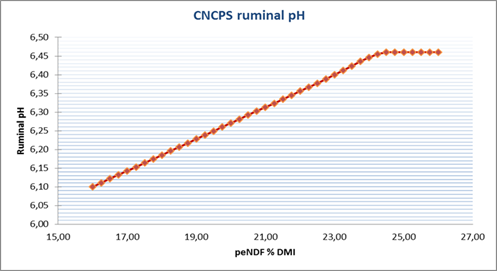
Historically, the CNCPS model estimates rumen pH through the physically effective NDF (peNDF). The diet peNDF is used to predict rumen pH and it affects the predicted nutrient supply through the impacts of ruminal pH on degradation rate of potentially digestible fiber (pdNDF), which in turn affects yield of fiber digesting bacteria and maximum bacterial yield.

However, it is well known that several factors affect ruminal pH. Among these factors, we can include:
− total dry matter and fermentable organic matter;
− ruminally digestible starch;
− amount and composition of fiber and nonfibrous carbohydrate;
− particle size and buffering capacity of the diet;
− intake of silage;
− rate of feed intake;
− chewing activity;
− capture of hydrogen ions by products of digestion;
− changes in the stoichiometry of fermentation;
− absorption or passage of VFA.
Therefore, the prediction of ruminal pH using only the peNDF explains only a portion of the variation in rumen pH that we find in practice, and this contributes to a lack of accuracy of the ruminal pH as estimated by CNCPS.
In addition, it is often explained that subclinical acidosis is caused by insufficient dietary effective fiber, which is fiber that stimulates chewing. In fact, as already said, the Cornell model predicts ruminal pH directly from effective fiber (% of DM intake) using data from dairy, beef, and sheep (Pitt et al. 1996). However, when only lactating cows are considered several research studies do not support the finding that peNDF is the only determinant of pH.
Canadian researchers (Beauchemin et al., 2000) compiled data for dairy cows from numerous publications in which cows were fed a variety of diets. The relationship between pH and fiber was poor, whether measured as NDF, NDF from forage, or effective NDF. Thus, simply increasing the fiber or effective fiber content of the diet does not guarantee an increase in ruminal pH. One must also consider the DM intake of the cows, the fermentability of the diet, and feeding management factors. That is not to say that fiber does not play a role in maintaining optimum pH in the rumen, merely that many additional factors also must be considered.
Ruminal pH is the resulting balance between factors that lead to the production of fermentation acids and those that remove or neutralize acids. Ruminal acidosis occurs when the production of fermentation acids, exceeds the ability of the animal to remove or neutralize the acids produced (Allen 1997).
The development of effective strategies that minimize ruminal acidosis must be based on an understanding of the factors that promote acid production and the factors that remove acids from the rumen.
Rumen pH in NDS
Giving the increasing attention paid to avoiding costs arising from SARA and with the goal of increasing the accuracy and sensitivity in the rumen pH prediction, RUM&N R&D decided to develop an alternative model for the prediction of rumen pH, compared to that proposed by CNCPS.

Please note that the NDS rumen pH does not replace the CNCPS rumen pH, nor does it affect CNCPS model predictions in any way, but it is shown alongside CNCPS pH in order to provide an alternative evaluation of pH. In other words, the CNCPS model continues to use his own predicted pH, while the NDS rumen pH is supplied for further evaluations outside of the CNCPS.
We used a meta-analytic approach and a dataset with dietary information and ruminal pH responses was compiled from research trials with dairy cows and beef cattle conducted internationally over the last years.
Although each of the factors mentioned above may play a role in the phenomenon of ruminal pH, the NDS Ruminal pH sub-model follows a simple two-stage approach to estimating pH based on easily measured or estimated variables according the approach proposed by D. Sauvant and D. Mertens (1998), with some adjustments and adaptations:
Stage 1. Establish a baseline ruminal pH that is estimated using a global approach, drawn on numerous data, and from feed intake levels of forages and concentrates, which the NDS platform easily calculates. This estimate is based on the intake of forages and concentrates expressed as a percentage of body weight. Using the relatively simple variables of %FI (Forage Intake %BW) and %CI (Concentrate Intake %BW), this estimate takes into account the effects of intake and differences in the organic matter fermentability and overall particle size between forages and concentrates.
It must be considered that the value of total forage of the diet is adjusted for the grains content when corn silage and small grain silages are included in the diet.
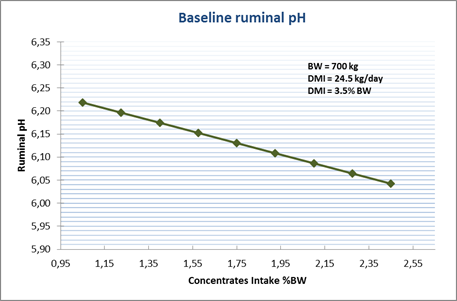
Stage 2. The application of marginal equations, based on chemical and physical diet characteristics, which correct and make more accurate the value of pH obtained through the Stage 1.
The adjustments of the baseline ruminal pH are obtained by evaluating:
− differences in fiber content (NDF)
− particle size (peNDF) and particle density (PD)
− ruminally degradable starch (RDS)
− ration buffers ingredient contents
These marginal adjustments are assumed to be additive with each other.
Fiber content
Several studies have described and demonstrated non-linear responses of the rumen pH to changes of diet NDF (% DM). However, from a model standpoint, a linear relationship can be applied in order to estimate a pH change adjustment to the baseline ruminal pH.
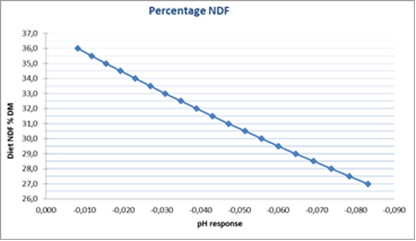
Particle size and Particle density
Particle size and particle density, which is the inverse of mean particle size (mm), provide further adjustments to pH.
An algorithm involving physically effective NDF content estimates current mean particle size of the diet. The reduction of diet particle size (pef factor) often significantly increases the ratio between the mass of the substrate and its surface available for fixing and microbial attack. This aspect results in accelerated fermentative processes and, consequently, it leads to an impact on rumen pH.
In practice, the relationship between pH and average particle size of the diet is not linear and the variations of the particle size (peNDF) would not have a major influence for ruminal pH conditions with mean particle size above 3.0-3.5 mm. However, when the mean particle size is below 3.0 mm, the reduction of the pH appears very marked.
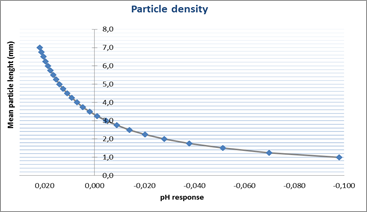
Ruminally degradable starch
Another important adjustment is obtained using ruminally degradable starch (%DM) predicted by CNCPS model. It is a linear adjustment with a breakeven point around 17 % of diet RDS.
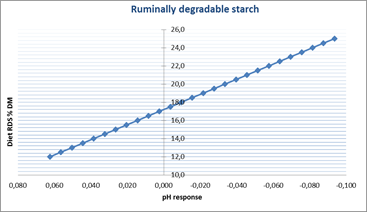
Buffers content
It is extensively demonstrated that rumen pH can be significantly increased as a result of the inclusion of buffers ingredients in the diet. The smaller the initial pH value the more marked and evident the response to buffer is. Thus, it is found that the effectiveness of buffer is greater when the rumen acidity is more pronounced, although the NDS pH model defines a plateau for the rumen pH response based on research data and practical observations.
This way, the pH response is then related to the level of buffers ingredient actually included in the diet (% DM), so as to define the adjustment of the baseline pH due to diet addition of buffer ingredients.
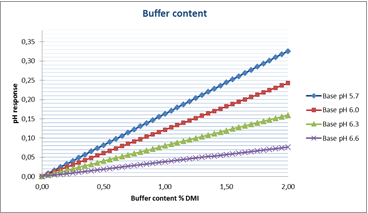
The rumen pH predicted as above, estimates the average daily pH; other algorithms, based on the interpretation of large bibliographic databases gathering published in vivo measurements on rumen pH, are included in order to estimate minimum and maximum pH expected during the day.

However, ruminal pH fluctuations are affected by diet and frequency of eating so, the predicted minimum and maximum pH do not describe the evolution of these fluctuations, but they only give an idea of the expected variation around the average value and the range between them.